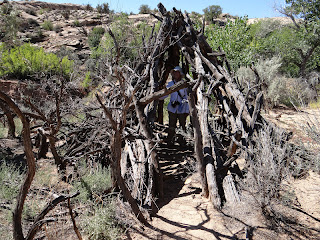Yesterday we also visited Monarch Cave, which is a major Pueblo III ruin in Comb Ridge.
The trail there turned out to be harder to follow than we imagined, even with GPS readings to help us. We had to find our way up and down arroyos and thickets of brush. Fortunately, for a while, a group passed us that seemed to know the path. But Janet had to stop and tie her shoe. Now she had to rely on my tracker instincts. Of course, I went up the slickrock, when I should have stayed down in the canyon. But at least I could see the trail from up there. But not the group ahead of us.
When we arrived at Monarch Cave, the group ahead was just leaving. Fortuitous. Now we had to climb up several ledges to get into the ruins. Below the cave are a deep drop-off and a very large pool of water that have to be circumvented.
The setting was quite dramatic,
as were the ruins themselves.
Unfortunately, we entered the ruins from the right side of the alcove and discovered that there was no way to get from the right side to the main ruins without crossing a narrow ledge between us and the ruins.
Usually, we are extremely cautious. I guess it was late in the day, and our judgment a bit impaired. Anyway, we crossed the narrow ledge, which consisted of only tiny 3-4 inch footholds and no hand holds. Not very smart, especially with a backpack on my pack. (The crossing was not directly above the water pool or canyon floor--we are not that stupid.) I even hit my head lunging into the narrow doorway guarding the ruin from intruders.
But we succeeded, and Janet took a quick breather.
There were goodies inside the ruin, like this metate
and original Anasazi ears of corn found in it.
There was another broken metate and corn.
The roof still had original beams and jacal fill.
The front of the ruin had obviously been a tower kiva, like those we saw at Hovenweep.
On one wall was an inscription
left by one of the early exploring parties in 1892 (not Wetherill's).
It did not look like there was any way out of the ruins except to return by way of the ledge we came across on. When I started back, however, I realized the folly of this path. We found another path down, using our butts as well as our heads--and some fortuitously placed cracks in the ledge.
On the 28th we attempted to hike to the ruins called Fishmouth Cave. We were unsuccessful this time, because the trail was very vague and we decided to move on to another site rather than wasting time. It was not that spectacular a ruin anyway, from what I had read.
But we had a nice surprise on the muddy way back to the car. We spotted an old, abandoned Navajo hogan.
One guidebook had ridiculously labeled it as a "Tee-pee." That, of course, is laughable. Another, somewhat more knowledgeable guidebook refers to it as a "sweatlodge." That is possible, but the construction and entrance makes it much more likely to be a "male" forked-stick hogan. I have seen pictures of "Changing Woman" (mother of the Navajo and Apache people) in just such a creation hogan.
Deep in another canyon off the Butler Wash Road was "Long Fingers Ruin."
Again, there was a nicely preserved ruin on the second level.
It had a very unusual pictograph in the form of a couple of "targets."
The use of green and white colors is unusual.
The lower level had to be entered through a spiny cactus field.
It was obviously well visited and not in great shape.
Some rooms were still standing, however, and open for careful inspection.
On the wall above the rooms were the pair of hands with the very unusual long fingers.
Was this part of an awareness of what makes humans so distinct--as toolmakers and craftsmen?
There were other more typical Anasazi peckings, like the "lizard" man."
An abstract triangle may have been a symbol of female creativity.
Thanks to previous visitors, pottery shards were left for the edification of intruders.
Federal law protects even shards like these. Archaeologists count and catalog each shard as part of an attempt to statistically determine cultural origins and exchange.
Before leaving, we climbed behind the ruins and noticed a disturbing site deep into the back of the alcove.
The evidence of looting was all too clear.
These were not the people who left potshards. These were looters (pothunters) who had dug up mummies and stolen whatever grave goods that were still in good condition for sale on the black market. They did not even bother to cover up the deep holes they had dug.































No comments:
Post a Comment